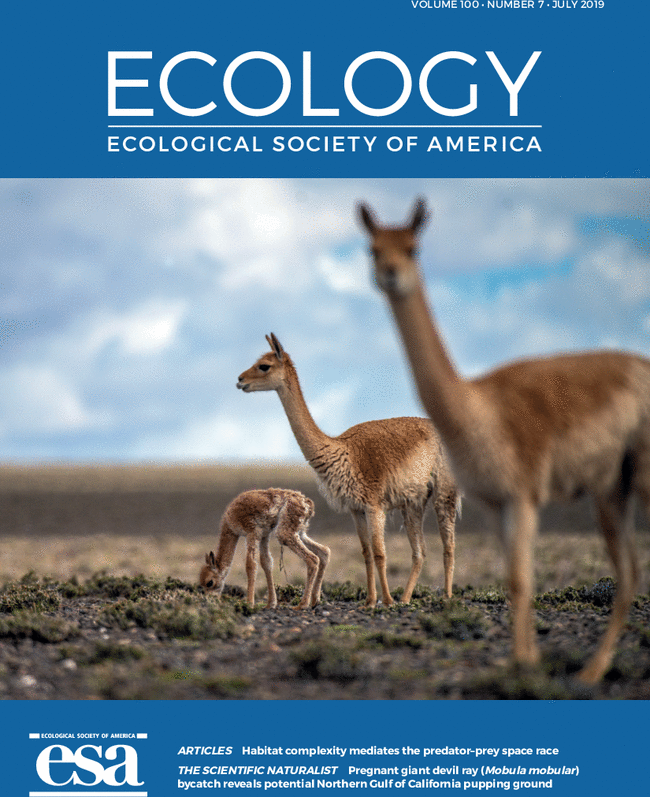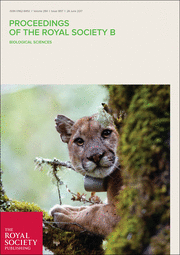Publications
Lab members appear in bold
Google Scholar | ResearchGate
2025
Barton, K. A., P. B. Finnerty, R. Rupasinghe, C. González-Crespo, J. E. Mahar, J-S. Eden, N. Y. Meisuria, B. Martínez-López, T. M. Newsome, A. J. Peel, J. A. Smith, and V. J. Brookes. 2025. The final frontier: using carcasses for One Health surveillance at the ecosystem interface. Frontiers of Veterinary Science 27(12).
Calhoun, K., J. A. Smith*, M. W. Tingley*, A. Heeren, A. Van Scoyoc, M. Serota, J. Brashares, and B. J. Furnas. 2025. Human-wildlife conflict is amplified during periods of drought. Science Advances 11(46). *authors contributed equally
Gaynor, KM et al. 2025. The influence of human presence and footprint on animal space use in US national parks. Proceedings of the Royal Society: Biological Sciences 292(2051):20251013.
Rice, M. M., S. J. Tumber-Dávila, M. D. Baiz, S. J. Cheng, K. Darragh, C. O. Estien, J. W. Hammond, D. D. Ignace, L. Khadempour, K. M. Gaynor, K. Mills, J. A. Smith, and A. C. Moore. 2025. Language matters: terminology in ecology and evolutionary biology disproportionately harms marginalized groups. PLOS Biology 23(1):e3002933.
Bolas, E. C., A. Pingatore, M. Mathur, D. T. Blumstein, S. P. D. Riley, J. A. Sikich, J. A. Smith, J. F. Benson, R. V. Blakey. 2025. Human recreation influences activity of a large carnivore in an urban landscape. Biological Conservation 301:110812.
2024
Beltran, R. S., A. M. Kilpatrick, S. Picardi, B. Abrahms, G. M. Barrile, W. K. Oestreich, J. A. Smith, M. F. Czapanskiy, A. B. Favilla, R. R. Reisinger, J. M. Kendall-Bar, A. R. Payne, M. S. Savoca, D. G. Palance, S. Andrzejaczek, D. M. Shen, T. Adachi, D. P. Costa, N. A. Storm, C. M. Hale, and P. W. Robinson. 2024. Maximizing biological insights from instruments attached to animals. Trends in Ecology and Evolution 40(1):37-46.
Gaynor, K. M., B. Abrahms, K. R. Manlove, W. K. Oestreich, and J. A. Smith. 2024. Anthropogenic impacts at the interface of animal spatial and social behaviour. Philosophical Transactions B 379(1912):20220527.
John, C., T. Avgar, K. Rittger, J. A. Smith, L. W. Stephenson, T. R. Stephenson, and E. Post. 2024. Pursuit and escape drive fine-scale movement variation during migration in a temperate alpine ungulate. Scientific Reports 14:15068.
Baldwin, R. A., J. A. Smith, and R. D. Meinerz. 2024. Identifying black rat (Rattus rattus) movement patterns aids the development of management programs in citrus orchards. Wildlife Research 51:WR23149.
Smith, J. A., M. E. McDaniels, S. D. Peacor, E. C. Bolas, M. J. Cherry, N. J. Dorn, O. K. Feldman, D. L. Kimbro, E. K. Leonhardt, N. E. Peckham, M. J. Sheriff, and K. M. Gaynor. 2024. Population and community consequences of perceived risk from humans in wildlife. Ecology Letters 27(6):e14456.
Monk, J. D., E. Donadio, J. A. Smith, P. L. Perrig, A. D. Middleton, and O. J. Schmitz. 2024. Predation and biophysical context control long-term carcass nutrient inputs in an Andean ecosystem. Ecosystems 27:346–359.
2023
Molina, F. J., J. A. Smith, E. Donadio, A. D. Middleton, J. N. Pauli, and J. R. Goheen. 2023. Food limitation reduces risk avoidance by prey, but does not increase kill rates in a simple predator-prey system. Ecosphere 14(11):e4701.
Serieys, L. E. K., J. M. Bishop, M. S. Rogan, J. A. Smith, J. P. Suraci, M. J. O’Riain, and C. C. Wilmers. 2023. Anthropogenic activities and age class mediate carnivore habitat selection in a human-dominated landscape. iScience 26(7):107050.
Karandikar, H., E. Donadio, J. A. Smith, O. R. Bidder, and A. D. Middleton. 2023. Spatial ecology of the vicuña (Lama vicugna) in a high Andean protected area. Journal of Mammalogy 104(3):509-518.
Van Scoyoc, A., J. A. Smith, K. M. Gaynor, K. Barker, and J. S. Brashares. 2023. The influence of human activity on predator-prey spatiotemporal overlap. Journal of Animal Ecology 92(6):1124-1134.
Cheng, S.*, K. M. Gaynor*, A. C. Moore*, K. Darragh+, C. O. Estien+, J. W. Hammond+, C. Lawrence+, M. D. Baiz#, L. Khademour#, M. A. McCary#, D. Ignace#, M. M. Rice#, S. J. Tumbler-Dávila#, and J. A. Smith*. 2023. Championing inclusive terminology in ecology and evolution. Trends in Ecology and Evolution 38(5):381-384. *authors contributed equally; +authors contributed equally; #authors contributed equally
2022
Baldwin, R. A, J. A. Smith, R. Meinerz, and A. B. Shiels. 2022. Managing roof rats in citrus orchards: initial efforts toward building an integrated pest management program. Proceedings of the Vertebrate Pest Conference 30.
Perrig, P., S. Lambertucci, E. Donadio, J. A. Smith, A. D. Middleton, and J. N. Pauli. 2022. Risk effects cascade up to an obligate scavenger. Ecology 104(2):e3871.
Peacor, S. D., N. J. Dorn, J. A. Smith, N. Peckham, M. J. Cherry, M. J. Sheriff, and D. L. Kimbro. 2022. A skewed literature: few studies evaluate the contribution of predation risk effects to natural field patterns. Ecology Letters 25(9):2048-2061.
Suraci, J. P.*, J. A. Smith*, S. Chamaillé-Jammes, K. M. Gaynor, M. Jones, B. Luttbeg, E. G. Ritchie, M. J. Sheriff, and A. Sih. 2022. Beyond spatial overlap: harnessing new technologies to resolve the complexities of predator-prey interactions. Oikos 2022(8):e09004. *authors contributed equally. Editor's Choice.
Monk, J. D.*, J. A. Smith*, E. Donadio, P. L. Perrig, R. D. Crego, M. Fileni, O. R. Bidder, J. N. Pauli, O. J. Schmitz, and A. D. Middleton. 2022. Cascading effects of a disease outbreak in a remote protected area. Ecology Letters 25(5):1152-1163. *authors contributed equally
Reilly, C., J. P. Suraci, J. A. Smith, Y. Wang, and C. C. Wilmers. 2022. Mesopredators retain their fear of humans across a gradient of human footprint. Behavioral Ecology 33(2):428:435.
2021
Sebastián-González, E. et al. 2021. Functional traits driving species role in the structure of terrestrial vertebrate scavenger networks. Ecology 102(12):e03519.
Smith, J. A.*, K. M. Gaynor*, and J. P. Suraci*. 2021. Mismatch between risk and response may amplify lethal and non-lethal effects of humans on wild animal populations. Frontiers in Ecology and Evolution 9:604973. *authors contributed equally
Xu, W., K. Barker, A. Shawler, A. Van Scoyoc, J. A. Smith, T. Mueller, H. Sawyer, C. Andreozzi, O. R. Bidder, H. Karandikar, S. Mumme, E. Templin, and A. D. Middleton. 2021. The plasticity of ungulate migration in a changing world. Ecology 102(4):e03293.
2020
Smith, J. A., E. Donadio, O. R. Bidder, J. N. Pauli, M. J. Sheriff, P. L. Perrig, and A. D. Middleton. 2020. Where and when to hunt? Decomposing predation success of an ambush carnivore. Ecology 101(12):e03172.
Gaynor, K. M., M. J. Cherry, S. L. Gilbert, M. T. Kohl, C. L. Larson, T. M. Newsome, L. R. Prugh, J. P. Suraci, J. K. Young, and J. A. Smith. 2020. An applied ecology of fear framework: linking theory to conservation practice. Animal Conservation 24(3):308-321.
Smith, J. A.*, J. P. Suraci*, J. S. Hunter, K. M. Gaynor+, C. Keller+, M. S. Palmer+, J. L. Atkins, I. Castañeda, M. J. Cherry, P. M. Garvey, S. Huebner, D. J. Morin, L. Teckentrup, M. J. A. Weterings, and L. Beaudrot. 2020. Zooming in on mechanistic predator-prey ecology: integrating camera traps with experimental methods to reveal the drivers of ecological interactions. Journal of Animal Ecology 89(9):1997-2012. *authors contributed equally; +authors contributed equally.
Sebastián-González, E. et al. 2020. Network structure of vertebrate scavenger assemblages at the global scale: drivers and ecosystem functioning implications. Ecography 43(8):1143-1155.
2019
Suraci, J. P., J. A. Smith, M. Clinchy, L. Y. Zanette, and C. C. Wilmers. 2019. Humans, but not their dogs, displace pumas from their kills: an experimental approach. Scientific Reports 9:12214.

Smith, J. A., E. Donadio, J. N. Pauli, M. J. Sheriff, O. R. Bidder, and A. D. Middleton. 2019. Habitat complexity mediates the predator-prey space race. Ecology 100(7):e02724. Featured on cover.
Sebastián-González, E. et al. 2019. Scavenging in the Anthropocene: human impact drives macroecological patterns of vertebrate scavenger richness. Global Change Biology 25(9):3005-3017.
Smith, J. A., E. Donadio, J. N. Pauli, M. J. Sheriff, and A. D. Middleton. 2019. Integrating temporal refugia into landscapes of fear: prey exploit predator downtimes to forage in risky places. Oecologia 189(4):883-890.
Smith, J. A., T. P. Duane, and C. C. Wilmers. 2019. Moving through the matrix: promoting permeability for large carnivores in a human-dominated landscape. Landscape and Urban Planning 183:50-58.
2018
Smith, J. A., A. C. Thomas, T. Levi, Y. Wang, and C. C. Wilmers. 2018. Human activity reduces niche partitioning among three widespread mesocarnivores. Oikos 127:890-901.
2017
Wang, Y., J. A. Smith, and C. C. Wilmers. 2017. Residential development influences on puma behavior, movement, and energetics in a fragmented landscape. PLoS ONE 2:e0184687.

Smith, J. A., J. P. Suraci, M. Clinchy, A. Crawford+, D. Sampson, L. Y. Zanette*, and C. C. Wilmers*. 2017. Fear of the human “super predator” reduces feeding time in large carnivores. Proceedings of the Royal Society Biological Sciences 284:20170433. +undergraduate author; *authors contributed equally. Featured on cover.
Suraci, J. P., M. Clinchy, B. Mugerwa, M. Delsey, D. W. Macdonald, J. A. Smith, C. C. Wilmers, L. Y. Zanette. 2017. A new Automated Behavioural Response system to integrate playback experiments into camera trap studies. Methods in Ecology and Evolution 8:957-964.
2016
Smith, J. A., Y. Wang, and C. C. Wilmers. 2016. Spatial characteristics of residential development shift large carnivore prey composition. Journal of Wildlife Management 80(6):1040–1048.
2015
Allen, M. L., H. U. Wittmer, P. Houghtaling, J. A. Smith, L. M. Elbroch, and C. C. Wilmers. 2015. The role of scent marking in mate selection by female pumas (Puma concolor). PloS ONE 10(10):e0139087.

Wilmers, C. C., B. Nickel, C. M. Bryce, J. A. Smith, R. E. Wheat, and V. Yovovich. 2015. The golden age of bio-logging: how animal-borne sensors are advancing the frontiers of ecology. Ecology 96(7):1741–1753. Featured on cover.
Smith, J. A., Y. Wang, and C. C. Wilmers. 2015. Top carnivores increase their kill rates on prey as a response to human-induced fear. Proceedings of the Royal Society Biological Sciences 282(1802):20142711.
2013
Smith, J. A., and L. P. Erb. 2013. Patterns of selective caching behavior of a generalist herbivore, the American pika (Ochotona princeps). Arctic, Antarctic, and Alpine Research 45(3):396-403.

